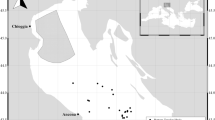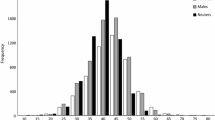Abstract
Reproduction and maturation in the economically important, but data-deficient, Mustelus minicanis and M. norrisi were analysed using catches of populations exploited by a gillnet fishery during two years in the southern Caribbean Sea. In total, 691 female (mean ± SD total length–TL of 55.3 ± 5.8 cm) and 503 male (50.4 ± 4.9 cm TL) M. minicanis were assessed, with ~95% of all specimens deemed mature. Almost 25% of females were gravid (occurring between January and October) and with variable temporal development of up to six embryos (3.3 ± 1.2), implying protracted temporal parturition. Parity in the sex ratio of embryos, but not in landed catches, suggested sexual segregation across the fished area. The 50% sizes at maturity (M 50) (± SE) were similarly estimated at 45.11 (± 0.39) and 45.48 (± 0.42) cm TL for females and males, respectively. Relatively fewer (235) M. norrisi were landed, with samples comprising 150 females (82.6 ± 18.1 cm TL) and 85 males (75.5 ± 17.7 cm TL). More than 30% of both sexes were immature. Ten percent of females were gravid (up to 11 embryos) and present in catches between October and February, coinciding with the northern hemisphere autumn/winter. Female and male M 50s were 76.65 (± 1.16) and 69.63 (± 1.92) cm TL, respectively. The results imply variable inter-specific reproductive plasticity and the need for further life-history studies. Increasing gillnet selectivity might represent a simple precautionary management option for concurrently regulating catches of the smaller-bodied M. minicanis during peak abundances of gravid females and similar-sized juvenile M. norrisi.





Similar content being viewed by others
References
Acosta AR, Appeldoorn RS (1995) Catching efficiency and selectivity of gillnets and trammel nets in coral reefs from southwestern Puerto Rico. Fish Res 22:175–196
Boomer JJ, Harcourt RG, Malcolm PF, Stow AJ (2012) Genetic divergence, speciation and biogeography of Mustelus (sharks) in the central indo-Pacific and Australasia. Mol Phylogenet Evol 64:697–703
Carlson J, Cortés E (2003) Gillnet selectivity of small coastal sharks off the southeastern United States. Fish Res 60:405–414
Cervigón F (1966) Los peces marinos de Venezuela, vol 1. Fundación La Salle de Ciencias Naturales, Caracas
Cervigón F, Alcalá A (1999) Los peces marinos de Venezuela: Tiburones y rayas, vol 5. Fundación Museo del Mar, Caracas
Compagno LJV (1984) FAO species catalogue. Vol. 4. Sharks of the world. An annotated and illustrated catalogue of shark species known to date. Part 1, Hexanchiformes to Lamniformes. Part 2, Carcharhiniformes, FAO fish. Synop 125
Conrath C (2004) Reproductive biology. In: Musick J, Bonfill R (eds) elasmobranch fisheries management techniques. APEC secretariat, pp. 133–164
Conrath CL, Musick JA (2002) Reproductive biology of the smooth dogfish, Mustelus canis, in the Northwest Atlantic Ocean. Env Biol Fish 64:367–377
Cortés E (1998) Demographic analysis as an aid in shark stock assessment and management. Fish Res 39:199–208
Cortés F, Jaureguizar AJ, Menni RC, Guerrero RA (2011) Ontogenetic habitat preferences of the narrownose smooth-hound shark, Mustelus schmitti, in two southwestern Atlantic coastal areas. Hydrobiologia 661:445–456
Daly-Engel TS, Seraphin KD, Holland KN, Coffey JP, Nance HA, Toonen RJ, Bowen BW (2012) Global phylogeography with mixed-marker analysis reveals male-mediated dispersal in the endangered scalloped hammerhead shark (Sphyrna lewini). PLoS One 7:e29986
Davis B, Worm B (2013) The international plan of action for sharks: how does national implementation measure up? Mar Pol 38:312–320
Dulvy NK et al (2014) Extinction risk and conservation of the world’s sharks and rays. elife 3:e00590
Francis M (1988) Movement patterns of rig (Mustelus lenticulatus) tagged in southern New Zealand. NZ J Mar Freshw Res 22:259–272
Francis MP (2003) Mustelus lenticulatus. The IUCN red list of threatened species 2016-2 http://www.iucnredlist.org. Accessed 9 Sept 2016
Giresi MM, Grubbs RD, Portnoy DS, Gold JR (2013) A morphological key to distinguish among smoothhound sharks (genus Mustelus) in the Gulf of Mexico. Proc Gulf Caribb Fish Inst 65:143–146
Giresi MM, Grubbs RD, Portnoy DS, Driggers WB, Jones L, Gold JR (2015) Identification and distribution of morphologically conserved smoothhound sharks in the northern Gulf of Mexico. Trans Am Fish Soc 144:1301–1310
Heemstra PC (1997) Review of the smooth-hound sharks genus Mustelus, family Triakidae of the western Atlantic Ocean, with descriptions of two new species and a new sub-species. Bull Mar Sc 60:894–928
Hozbor N, Vooren CM, Lamónaca AF (2004) Mustelus fasciatus. The IUCN red list of threatened species 2004: e.T44581A10908329. Accessed 9 Sept 2016
IUCN (2016) Mustelus. The IUCN red list of threatened species. Version 2016-2. <www.iucnredlist.org>. Accessed 9 Sept 2016
Jensen JW (1995) A direct estimate of gillnet selectivity for brown trout. J Fish Biol 46:857–861
Jones LM, Kyne PM, Carlisle AB (2009) The IUCN red list of threatened species 2009-2: e.T161518A5441575. Accessed 17 Nov 2016
Kirkwood GP, Walker TI (1986) Gill net mesh selectivities for gummy shark, Mustelus antarcticus Günther, taken in south-eastern Australian waters. Mar Freshw Res 37:689–697
Leandro L, Caldas JP (2006) Mustelus minicanis. The IUCN red list of threatened species 2016-2: e.T60205A12318893. Accessed 9 Sept 2016
Massa A, Hozbor N, Chiaramonte GE, Balestra AD, Vooren CM (2006) Mustelus schmitti. The IUCN red list of threatened species 2016-2. E.T60203A12318268. Accessed 9 Sept 2016
McAuley RB (2011) Mustelus ravidus. The IUCN red list of threatened species 2011: e.T63165A12625425. Accessed 9 Sept 2016
Mendonça FF, Oliveira C, Gadig OBF, Foresti F (2011) Phylogeography and genetic population structure of Caribbean sharpnose shark Rhizoprionodon porosus. Rev Fish Biol Fisheries 21:799–814
Mendoza J (2015) Rise and fall of Venezuelan industrial and artisanal marine fisheries: 1950–2010. Fisheries Centre, Working Paper Series 27:1–15
Minns CK, Hurley DA (1988) Effects of net length and set time on fish catches in gill nets. N Am J Fish Manage 8:216–223
Navia A, Mejía-Falla P, Hleap JS (2016) Zoogeography of elasmobranchs in the Colombian Pacific Ocean and Caribbean Sea. Neotr Ichthyol 14:1–11
Neff BD, Pitcher TE (2005) Genetic quality and sexual selection: an integrated framework for good genes and compatible genes. Mol Ecol 14:19–38
Oliver S, Braccini M, Newman SJ, Harvey ES (2015) Global patterns in the bycatch of sharks and rays. Mar Pol 54:86–97
Pauly D, Zeller D (2016) Catch reconstructions reveal that global marine fisheries catches are higher than reported and declining. Nat Commun 7:10244. doi:10.1038/ncomms10244
Pereyra S, García G, Miller P, Oviedo S, Domingo A (2010) Low genetic diversity and population structure of the narrownose shark (Mustelus schmitti). Fish Res 106:468–473
R Development Core T (2011) R: a language and environment for statistical computing. R Foundation for Statistical Computing, Vienna, Austria http://www.r-project.org/. Accessed 1 Dec 2011
Rigby CL, White WT, Smart JJ, Simpfendorfer CA (2016) Life histories of two deep-water Australian endemic elasmobranchs: Argus skate Dipturus polyommata and eastern spotted gummy shark Mustelus walkeri. J Fish Biol 88:1149–1174
Robertson R, Allen G (2016) Shorefishes of the tropical eastern Pacific: online information system. Version 2.0. Smithsonian Tropical Research Institute, balboa
Rosa MR, Gadig OBF (2010) Taxonomic comments and an identification key to species for the smooth-hound sharks genus Mustelus link, 1790 (Chondrichthyes: Triakidae) from the western South Atlantic. Pan-American J Aq Sc 5:401–413
Rudstam LG, Magnuson JJ, Tonn WM (1984) Size selectivity of passive fishing gear: a correction for encounter probability applied to gill nets. Can J Fish Aquat Sci 41:1252–1255
Saidi B, Bradai M, Bouian A (2009) Reproductive biology and diet of Mustelus punctulatus (Risso, 1826) (Chondrichthyes: Triakidae) from the Gulf of Gabès, central Mediterranean Sea. Sci Mar 73:249–258
Springer S (1939) Two new atlantic species of dog sharks, with a key to the species of Mustelus. Proc US Nat Mus 86:461–468
Tagliafico A, Rago N, Rangel S (2013) Fishery and biology of Rhinobatos percellens (Rajiformes: Rhinobatidae) caught by the artisanal fishery at la Pared beach, Venezuela. Rev Biol Trop 61:149–160
Tagliafico A, Hernández-Ávila I, Rangel M, Rago R (2015) Size of catch, reproduction and feeding of the small-eye smooth-hound, Mustelus higmani (Carcharhiniformes: Triakidae), in Margarita Island, Venezuela. Sci Mar 79:443–452
Uhlmann SS, Broadhurst MK (2015) Mitigating unaccounted fishing mortality in gillnets and traps. Fish Fish 16:183–229
Vila-Gispert A, Moreno-Amich R, García-Berthou E (2002) Gradients of life-history variation: an intercontinental comparison of fishes. Rev Fish Biol Fish 12:417–427
Walker TI (2016) Mustelus antarcticus. The IUCN red list of threatened species 2016: e.T39355A68634159. Accessed 9 Sept 2016
Weigmann S (2016) Annotated checklist of the living sharks, batoids and chimaeras (Chondrichthyes) of the world, with a focus on biogeographical diversity. J Fish Biol 88:837–1037
Worm B, Davis B, Kettemer L, Ward-Paige CA, Chapman D, Heithaus MR, Kessel ST, Gruber SH (2013) Global catches, exploitation rates, and rebuilding options for sharks. Mar Pol 40:194–204
Zagaglia CR, Damiano C, Hazin FHV, Broadhurst MK (2011) Reproduction in Mustelus canis (Chondrichthyes: Triakidae) from an unexploited population off northern Brazil. J Appl Ichth 27:25–29
Zeh D, Zeh J (2000) Reproductive mode and speciation: the viviparity-driven conflict hypothesis. BioEssays 22:938–946
Acknowledgements
We thank the fishers and fish retailers from La Pared, Juan Griego, Los Cocos and Conejeros for their kind cooperation in allowing us to measure the specimens. We also acknowledge the Instituto Nacional de Investigaciones Agrícolas (INIA) and A. Lárez for helpful logistical assistance. M. Barany, L. Zambrano, N. Ehemann and M. Harris provided further assistance in taxonomical identification of the specimens. E. Ron is thanked for receiving the specimens at the ichthyology collection of the Universidad de Oriente. Anonymous reviewers greatly improved the manuscript.
Author information
Authors and Affiliations
Corresponding author
Rights and permissions
About this article
Cite this article
Tagliafico, A., Rago, N., Rangel, S. et al. Aspects of the reproductive biology of the data-deficient Mustelus minicanis and M. norrisi (Chondrichthyes: Triakidae) in the southern Caribbean Sea. Environ Biol Fish 100, 785–795 (2017). https://doi.org/10.1007/s10641-017-0606-1
Received:
Accepted:
Published:
Issue Date:
DOI: https://doi.org/10.1007/s10641-017-0606-1




